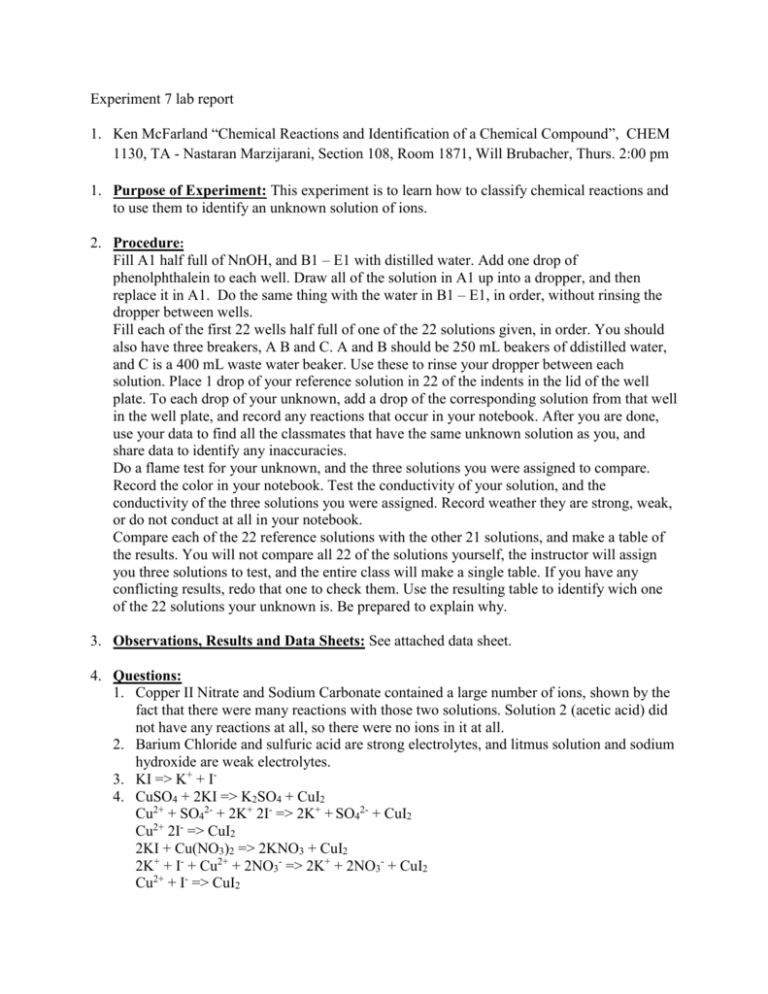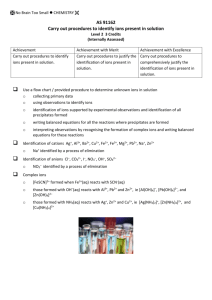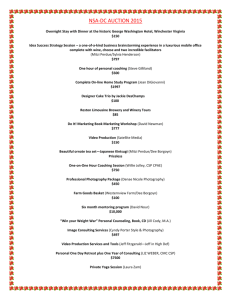Lab 7 lab report
advertisement

Experiment 7 lab report 1. Ken McFarland “Chemical Reactions and Identification of a Chemical Compound”, CHEM 1130, TA - Nastaran Marzijarani, Section 108, Room 1871, Will Brubacher, Thurs. 2:00 pm 1. Purpose of Experiment: This experiment is to learn how to classify chemical reactions and to use them to identify an unknown solution of ions. 2. Procedure: Fill A1 half full of NnOH, and B1 – E1 with distilled water. Add one drop of phenolphthalein to each well. Draw all of the solution in A1 up into a dropper, and then replace it in A1. Do the same thing with the water in B1 – E1, in order, without rinsing the dropper between wells. Fill each of the first 22 wells half full of one of the 22 solutions given, in order. You should also have three breakers, A B and C. A and B should be 250 mL beakers of ddistilled water, and C is a 400 mL waste water beaker. Use these to rinse your dropper between each solution. Place 1 drop of your reference solution in 22 of the indents in the lid of the well plate. To each drop of your unknown, add a drop of the corresponding solution from that well in the well plate, and record any reactions that occur in your notebook. After you are done, use your data to find all the classmates that have the same unknown solution as you, and share data to identify any inaccuracies. Do a flame test for your unknown, and the three solutions you were assigned to compare. Record the color in your notebook. Test the conductivity of your solution, and the conductivity of the three solutions you were assigned. Record weather they are strong, weak, or do not conduct at all in your notebook. Compare each of the 22 reference solutions with the other 21 solutions, and make a table of the results. You will not compare all 22 of the solutions yourself, the instructor will assign you three solutions to test, and the entire class will make a single table. If you have any conflicting results, redo that one to check them. Use the resulting table to identify wich one of the 22 solutions your unknown is. Be prepared to explain why. 3. Observations, Results and Data Sheets: See attached data sheet. 4. Questions: 1. Copper II Nitrate and Sodium Carbonate contained a large number of ions, shown by the fact that there were many reactions with those two solutions. Solution 2 (acetic acid) did not have any reactions at all, so there were no ions in it at all. 2. Barium Chloride and sulfuric acid are strong electrolytes, and litmus solution and sodium hydroxide are weak electrolytes. 3. KI => K+ + I4. CuSO4 + 2KI => K2SO4 + CuI2 Cu2+ + SO42- + 2K+ 2I- => 2K+ + SO42- + CuI2 Cu2+ 2I- => CuI2 2KI + Cu(NO3)2 => 2KNO3 + CuI2 2K+ + I- + Cu2+ + 2NO3- => 2K+ + 2NO3- + CuI2 Cu2+ + I- => CuI2









